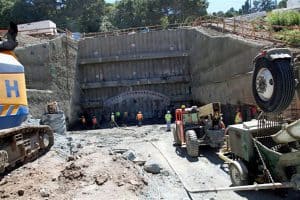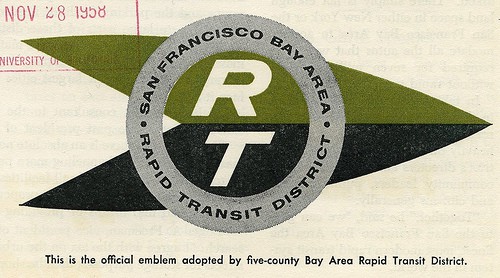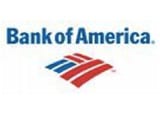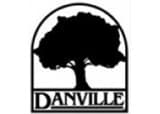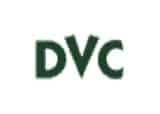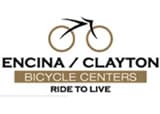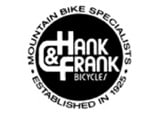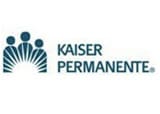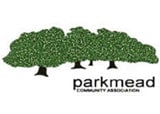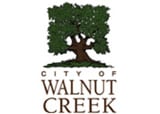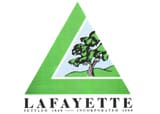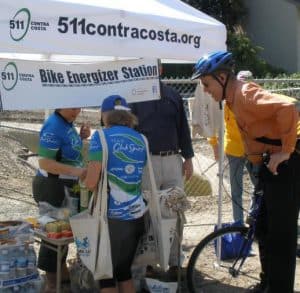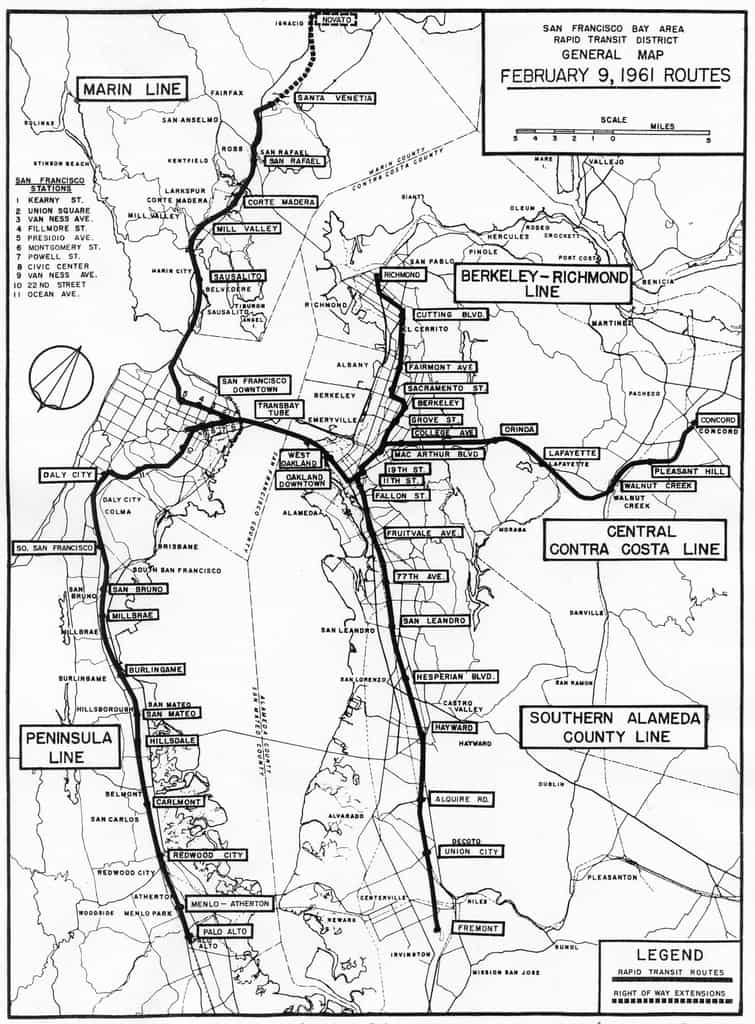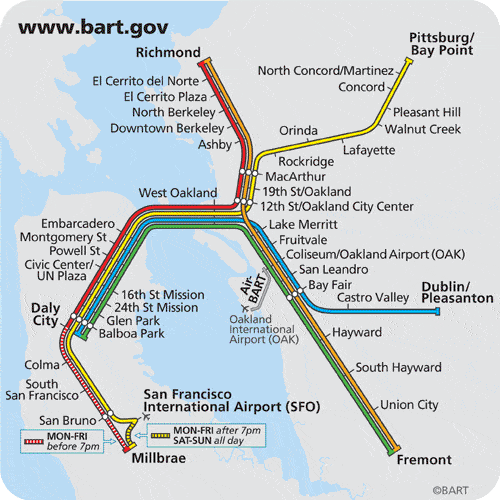Caltrans will close the connector between westbound Route 24 and Northbound Highway 13 beginning at 5PM on Friday, August 27 until Monday, August 30 at 5AM. Traffic seeking northbound Hwy 13 will be detoured onto the Caldecott Lane off-ramp. Signs will guide motorists to northbound Hwy 13.
Source:
• Caldecott-tunnel.org
Category: Uncategorized
Tunneling to begin Monday in Orinda
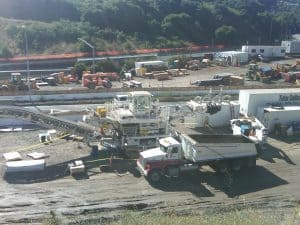
Caltrans contractors plan to start carving out the fouth bore of the Caldecott Tunnel on Monday. The roadheader that is being used for the project is a 130-ton, 54-foot-long and 14-foot-tall excavation device with a rotating cutter mounted on a boom. The roadheader will dig the 3,389-foot-long bore that will add two freeway lanes.
According to contracostatimes.com, the roadheader’s whirling teeth will dig into the hills after a short ceremony at 10 a.m. Monday to mark the milestone in the three-year construction project. Other machinery will dig the first few feet, and the roadheader will take over the excavation in about a week. Caltrans spokesman Jeff Weiss said, “There’s a very narrow window of opportunity to see the roadheader in the open. Then its underground until the project is finished.” To read more go to www.contracostatimes.com.
Source:
• contracostatimes.com
Major progress being made at East Portal
The wall shown in the photos below will eventually become the east portal wall. According to Caldecott-tunnel.org, most walls are built from the base upwards.
First, an auger drills large holes, ninety feet deep and several feet apart. Concrete is poured into the circular holes and allowed to harden. Next, a series of holes are drilled between the original holes, overlapping the edges. Steel cages are dropped into the holes for extra support and then concrete is poured into the hole. When the concrete hardens, it forms a series of underground interlinking piles.
Starting at the top of the wall, the dirt in slowly excavated revealing the front of the wall. Supports are added to the wall as the excavation goes deeper. According to Caldecott-tunnel.org, the machine in the lower photo is drilling holes to insert tie-back cables, which as the name indicates, will tie back the wall against the hillside. The semi-circular pattern on the wall in the top photo is the outline of the tunnel. The tunnel will be excavated straight through the portal wall. This could begin in as little as three weeks.
Source:
• Caldecott-tunnel.org
Original BART logo from 1958
Ready for a sweet trip back in time?
Here is the original Bay Area Rapid Transit logo from 1958:
Current Bay Area Rapid Transit logo:
Hat tip: Streetsblog SF | Photo credit: Eric Fischer
Related: San Francisco Bay Area Rapid Transit District General Map from February 9, 1961
Caldecott Closures Wednesday & Thursday, July 14-15
According to caldecott-tunnel.org, the left lane and the adjacent lane (#1 & #2) of westbound Route 24 before the Caldecott Tunnel will be closed Wednesday and Thursday nights, July 14-15 from 11:00 PM – 4:00 AM. The middle tunnel bore will also be closed during this time period.
Source:
• www.caldecott-tunnel.org
Several Caldecott Closures Tuesday Night July 13th
According to Caldecott-tunnel.org, the far right lane (#4) of westbound Route 24, before to the Caldecott Tunnel will be closed Tuesday night, July 13. The closure at 7:30 PM, with full closure in place by 8:30 PM. The closure will be until 4:00 AM.
Also, the Fish Ranch Road off-ramp and on-ramp will be closed from 9:00 PM – 5:00 AM.
That same night, Tunnel Bore #3 will be closed from 10:00 PM – 4:00 AM.
Source:
• www.caldecott-tunnel.org
Assembling of Tunnel Machine at East Portal
A giant roadheader, which was built in Northeastern Germany, was shipped to Oakland and assembled at the east portal of the Caldecott Tunnel. There are several weeks worth of work that must happen before the excavation can begin. According to Caldecott-tunnel.org, the $3.5 million dollar machine weighs 130 tons and has been attended to by several German workers who arrived with the machine to oversee its assembly and testing.
Source:
www.caldecott-tunnel.org
On-Off Ramps and Third Bore Night Closures
July 6-8 the far right lane (#4) of westbound Route 24 will be closed. Work crews will begin the closure at 7:30 PM and full closure will take place at 8:30 PM. The closure will take place until 4:00 AM.
During those nights, the Wilder off-ramp will be closed from 9:30 PM until 5:00 AM. The Wilder on-ramp will be closed from 11:30 PM until 5:00 AM. July 6-8 the Fish Ranch Road off-ramp will be closed from 9:00 PM. Until 5:00 AM.
According to Caldecott-tunnel.org, Caltrans crews will be installing electrical conduit as part of the Fourth Bore Project.
Source:
• www.caldecott-tunnel.org
AC Transit Bus Fuel Cell System Sets Durability Record

SOUTH WINDSOR, Conn., June 29, 2010 – UTC Power, a United Technologies Corp. (NYSE:UTX) company, announced yesterday it has set durability records for its latest generation transit bus fuel cell system.
A PureMotion® Model 120 fuel cell powerplant aboard an Alameda-Contra Costa Transit District (AC Transit) bus operating in the Greater Oakland, California, area has surpassed 7,000 hours in service with the original cell stacks and no cell replacements, and another has exceeded 6,000 hours.
“Based on industry data we’ve seen, these durability milestones are unmatched in the industry,” said Ken Stewart, UTC Power Vice President-Transportation. “We’ve worked very hard at UTC Power over the past several years to improve our fuel cell stack durability, which is recognized as a key challenge to commercializing fuel cell vehicles. These operating hour numbers demonstrate our significant progress.”
Three of AC Transit’s buses are equipped with UTC Power fuel cell systems and have now traveled more than 255,000 miles, with an average fuel economy that is 65 percent better than the control fleet of diesel buses running the same routes and duty cycles.
Fuel cell buses produce no harmful tailpipe emissions and provide a smooth, quiet ride for passengers. Transit buses with fuel cell systems can have a major impact on greenhouse gas reduction, ranging from a 43 percent reduction over diesel buses if hydrogen is supplied from the reformation of natural gas, up to a 100 percent reduction when hydrogen is generated from on-site renewable sources like solar and wind power.
“This is the type of result we and our industry are looking for as we make steady progress toward proving the commercial viability of fuel cell buses for public transit. We’re looking forward to applying the success of UTC Power’s newest fuel cell systems in our new fleet of 12 next-generation buses, as they enter passenger service over the next six months,” said Jaimie Levin, AC Transit’s Director of Alternative Fuels Policy and Hydrogen Fuel Cell Program Manager.
UTC Power is part of United Technologies Corp., which provides energy-efficient products and services to the aerospace and building industries. Based in South Windsor, Conn., UTC Power is a world leader in developing and producing fuel cells for on-site power at buildings and for transportation applications.
AC Transit serves more than 1.5 million people in 13 cities (including Oakland and Berkeley) and two counties in the East Bay of the San Francisco Bay Area. With a fleet of 600 buses, it carries more than 67 million passengers annually.
Source: UTC Press Release, June 29, 2010 AC Transit Fuel System (click to download)
Caldecott Tunnel Fourth Bore Construction Enters Phase Four
Construction on the fourth bore is expected to enter a new phase this week with assembly of the road header on the Orinda side in preparation to begin boring a hole in the mountain. Jeff Weiss, Caltrans spokesman said, “There’s still a lot of work to be done building the portal walls and retaining walls. Once that’s done we’re going to start boring and you’ll see dirt coming out of a new tunnel.”
Source:
• Caldecott Tunnel Construction in Phase Four- KCBS
Concrete Barrier was added at Fish Ranch Road
According to caldecott-tunnel.org, Caltrans crews added sections of concrete barrier to the southern edge of the pavement on Fish Ranch Road, adjacent to the area where the new retaining wall is being built. The barrier will prevent errant vehicles from traveling off the pavement over the steep hillside.
Source:
• www.caldecott-tunnel.org
This Week's Headlines in Transportation & Transit: Jun. 5-11, 2010
Upcoming Events & Meetings
- Fri. 6/11, Sat. 6/12: Treat Boulevard to close at night for Iron Horse Trail bridge installation
- Weds. 6/16: TransLink becomes Clipper
- Sun. 6/20: Ride on the historic Niles Canyon Railway through Niles Canyon
Local News (Contra Costa County & East Bay)
- Updates on Caldecott tunnel portal and retaining wall construction
- Officials break ground on Highway 4 Loveridge/Somersville segment
- Linde hydrogen technology to fuel AC Transit buses
- Senator Barbara Boxer tours Caldecott Tunnel
- Walnut Creek’s Free Ride awaits uncertain fate
Bay Area & California News
- Paper Fast Passes being phased out
- Approval of new BART budget means cleaner trains and possible temporary fare reduction
- Coulomb Technologies to install 4,600 electric vehicle charging stations, 1/3 in California
- Bay Bridge Gateway Park a chance for big ideas
- CA State Senate passes bill proposing tougher penalties for hands-free and texting violations
Other
Enter our monthly drawings for $25 gift cards to Peet’s Coffee & Tea
Caldecott Lane Closure
Work crews closed one lane of the Caldecott Lane just west of the Kay Street overpass on June 4th from 7pm to 11am on June 5th. The contractor, according to caldecottt-tunnel.org, was building a 240-foot right turn pocket at the southwest corner of Caldecott Lane and Kay Street. Caltrans and the contractor decided to do all the work over a weekend night instead of over the span of several nights or two weeks of shifts. Relatively heavy traffic on Caldecott Lane restricts daytime lame closures to a six-hour periods between 9:00 a.m. – 3:00 p.m. during weekdays. Those short work windows, and time-consuming start up and shut-down operations would have prolonged the project for a period of two weeks.
Source:
Bike to Work Day 2010 posters
To see a neat collection of posters from this year’s Bike to Work Day put together by Los Medanos College in Pittsburg, CA, click the following link for a slideshow: Bike to Work Day 2010 posters
Have you noticed any traffic changes around the Caldecott Tunnel?
How has the construction affected traffic around the Caldecott Tunnel? Is it about the same as before? Have you noticed more carpooling? Please leave a comment below.
Bike to Work Day: Thursday May 13, 2010
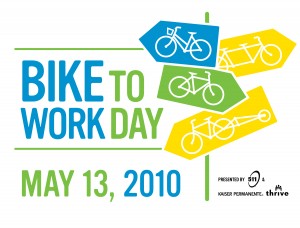
Bike to Work Day
Come help celebrate National Bike Month and California Bike Commute Week in May with Bike to Work Day. The Bay Area’s 16th annual Bike to Work Day will take place on Thursday, May 13th, 2010. Bike to Work Day is an event that helps to promote commuting by bicycle. Bike to Work Day in the San Francisco Bay Area is primarily funded by the Metropolitan Transportation Commission with the help of financial donations from event sponsors and volunteers. There are over 100 energizer stations throughout the region on Bike to Work Day where cyclists can stop by for refreshments and promotional items.
511 Contra Costa has supported cyclists and Energizer Station hosts throughout Contra Costa County since 2001 using Bay Area Air Quality Management District funds and the Contra Costa Transportation Authority’s half-cent sales tax for transportation funds.
Bike to Work Day Pre-Events
Hank and Frank’s Bike Shop Lafayette
Free bike safety checks – discount on commuter accessories!
Pre-event dates: May 3rd – May 7th
Store hours: Mon-Sat 10-6, Sun 11-5
3377 Mount Diablo Boulevard, Lafayette
Encina Bike Shop Walnut Creek
15% discount on bikes and accessories not already on sale. May 1st – May 14th
Free bike safety checks May 1st & 2nd and May 8th & 9th
Store hours: Mon-Sat 10-7, Sun 12-6
2901 Ygnacio Valley Road, Walnut Creek
Sports Basement Walnut Creek
Bike Clinic Tues. May 4th and Thurs. May 6th 6:30 – 7:30pm
Free bike safety checks April 26th – May 7th
1881 Ygnacio Valley Road, Walnut Creek
REI Brentwood
Free bike safety checks Sat. May 1st and Sat. May 8th 10am – 2pm
2475 Sand Creek Road, Brentwood
REI Concord
Free bike safety checks May 5 – May 12
Store hours: Mon-Fri 10-9, Sat 10-7, Sun 10-6
1975 Diamond Boulevard, Concord
Local Partners
Thanks to the following Public Agencies and Companies who are sponsoring Energizer Stations. We now have 36 Energizer Stations.
Bike to Work Day 2010 Energizer Stations in Contra Costa
Morning Stations
- Iron Horse Trail / Hemme Ave, 7:00am-9am, San Ramon Valley Street Smarts Program
Antioch
- Mokelumne Trail at Sutter Delta Hospital, 6:30am-9:30 am, City of Antioch
- Corner of Deer Valley Road and Wellness Way, 6:30am-9:30am, Kaiser Antioch Medical Center
Brentwood
- Sand Creek Road / Shady Willow Lane, 7am-10am, Brentwood REI
- City Park, 2nd and Oak Street, 7-9am, Delta Pedalers
Concord
- Concord BART, 7am-9am, Bank of America
Danville
- Iron Horse Trail/Hemme Ave 6:30-9 a.m., Town of Danville Police Dept and the San Ramon Valley Street Smarts Program
- Iron Horse Trail /Paraiso Drive , 6:30am-9am, Town of Danville and the San Ramon Valley Street Smarts Program
El Cerrito
- Bike Station on the Ohlone Greenway (across the path from the El Cerrito Plaza BART), 7am-9am, City of El Cerrito
El Sobrante
- 3826 San Pablo Dam Road (both sides of the street), 7am-9am, The Pedaler Bike Shop
Hercules
- Hercules Park and Ride Lot (by eLockers), 6am-9am, WestCAT, City of Hercules, 511 Contra Costa
Lafayette
- Lafayette BART Station, 7am-9am, Hank and Frank Bicycles
- Lafayette Plaza (Mt. Diablo Blvd / Moraga Road), 6:30am-8:30am, Lafayette Bike/Ped Advisory Committee
Martinez
- 5019 Imhoff Pl (1/2 mile off the north terminus of the Iron Horse Trail), 7am-8:30am, Central Contra Costa Sanitary District
- Capitol Corridor Station, 5:15am-8:45am, Richard Anderson
Orinda
- Moraga Way/Brookwood Rd, 6am-8am, City of Orinda
Pittsburg
- DeAnza Trail at Railroad, 7am-9am, City of Pittsburg
- LMC Campus – Quad Area, 9:30 am-12:30 pm, Los Medanos College
Richmond
- Bay Trail at Marina Bay Park, 6am-9am, the Boilerhouse Restaurant
- 914 Marina Way South at Main Entrance, 6:30am-9am, Kaiser Permanente Regional Laboratory
- Richmond BART Station near bike lockers in upper courtyard, 6-9am, City of Richmond
- The Greenway, Ohio Ave and 15th Street, 6-9am, Richmond Spokes
- Ohlone Greenway Trail, MacDonald/San Pablo Ave, 6-9am, City of Richmond
San Pablo
- 13052 San Pablo Ave, 7am-9am, CARS (Complete Auto Repair Service)
San Ramon
- Iron Horse Trail at San Ramon Transit Center/ Iron Horse Middle School, 6am-9am, City of San Ramon and the San Ramon Valley Street Smarts Program
- Iron Horse Trail / Bollinger Canyon, 6am-9am, Bishop Ranch Transportation Centre
Walnut Creek
- South Broadway / Newell, 7am-9am, Whole Foods Market
- Iron Horse Trail / Canal Trail Crossing, 6:30am-9am, County Connection
- Walnut Creek BART, 6am-9am, City of Walnut Creek and Sports Basement Walnut Creek
- Parkmead School / Newel Ave. at Magnolia, 7am-9am, Parkmead Association
- 2901 Ygnacio Valley Road / Breeze Way, 6:30am-9am, Encina Bike Shop
- North Wigget on the Canal Trail, 7am-9am, Renaissance Club Sport
Evening Stations
Antioch
- Mokelumne Trail at Sutter Delta Hospital, 4pm-6pm, City of Antioch
Danville
- Iron Horse Trail / behind Lunardi’s, 4pm-6pm, Integrated Science Solutions Inc
El Sobrante
- 3826 San Pablo Dam Road, Both Sides of Street, 4pm-6pm, The Pedaler Bike Shop
Lafayette
- Lafayette Plaza (Mt. Diablo Blvd. / Moraga Road), 3pm-5pm, Lafayette Chamber/ Green Committee
Pleasant Hill
- Pleasant Hill BART, 4pm-6:30pm, REI Concord
- Contra Costa Canal Trail / Golf Club Road, 4:30pm-6:30pm, DVC
San Ramon
- Iron Horse Trail / Bollinger Canyon, 3pm-5pm, Bishop Ranch Transportation Centre
Walnut Creek
- Walnut Creek BART, 4:30pm-6:30pm, Sports Basement Walnut Creek
- Iron Horse Trail / Canal Trail Crossing, 4pm-7 pm, 511 Contra Costa and Renaissance Club Sport
- 2901 Ygnacio Valley Road / Breeze Way, 4pm-7pm, Encina Bike Shop
- North Wigett on the Canal Trail, 4:30pm-7pm, Grafika Design Studio
- South Broadway / Newell, 4pm-6pm, Whole Foods Market
Evening on the Trails: An After-Hours Family Bicycling Event
Join us on the evening of Bike to Work Day for an after-hours bicyling event! Evening on the Trails will take place at four energizer stations: 1st and Buena Vista, Iron Horse Canal Trail Crossing, Contra Costa Canal Trail at Heather Farms and Civic Park at Ball Fields from 4pm – 6:30pm.
Not only will you have a chance to explore the trails and learn how to navigate through different neighborhoods and towns on your bike, but at each of the participating Evening on the Trails energizer stations you’ll be able to fill out a raffle ticket and have a chance to win a free kid’s bike.
Read more about this event in the Contra Costa Times article, Evening on the Trails offers family fun after hours, or click below the image to download the event flyer.
This year’s winner from Evening on the Trails was Emmett Lutz. Congratulations!
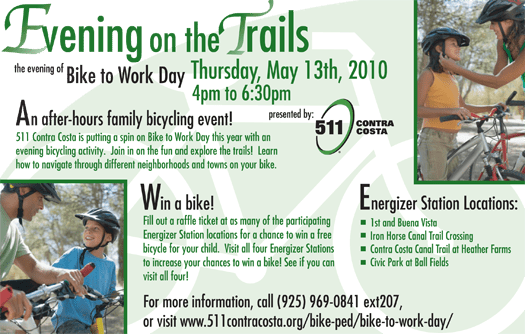
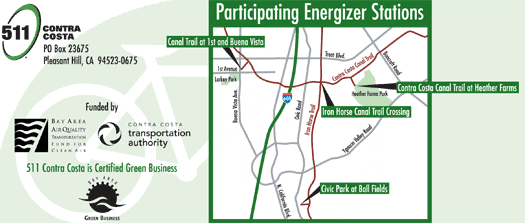
Download the full resolution version of the Evening on the Trails promotional materials.
Energizer Stations and Bike Maps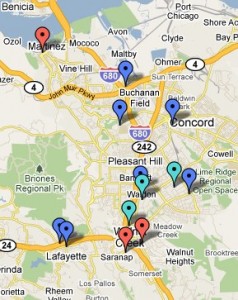
The Bike to Work Day website has google maps of energizer stations all over the bay area. Click here for a map of Contra Costa County energizer stations. A list of all energizer station region maps is available here.
Need help with your route? Check out our selection of free paper and on-line bike maps.
Bike to Work Day Team Challenge
In the Team Bike Challenge, groups of up to 5 cyclists competed to ride their bikes for transportation as many days as possible in the month of may. Points were given out based on the type of cyclist each team member was. Novices receive the most points (5 per trip) as the competition tried to encourage new bike commuters to ride together with more experienced cyclists for support and encouragement.
Read more about the Bike to Work Day Team Challenge
Nominate a Bike Commuter of the Year
Do you know someone in your community who is committed to making every day a “Bike to Work Day”? Does this person epitomize and actualize the health, environmental, social and economic benefits of bicycling? Share his or her story with You Can Bike There.
Bike to Work Day Materials
Download 11″ x 17″ Bike to Work Day Poster
Download 8 1/2″ x 11″ Bike to Work Day Poster
Bike to Work Day Photos
Our flickr stream is chock full of Bike to Work Day photos from years past. You can check out our photos from Bike to Work Day 2009 here. We are also compiling an archive of pre-2009 Bike to Work Day photos, which you can check out here.
Submit your photos and/or videos of Bike to Work Day to enter for a chance to win $25 Peet’s Coffee & Tea! Submissions must be sent by May 14, 2010 5pm PST to be eligible for the prize drawing. Send your photos and/or videos via Twitter or email them to bike@511contracosta.org.
[flickr-gallery mode=”photoset” photoset=”72157623794002109″]
Speeders on I-580 and I-680 face CHP crackdown
“Am I going to get pulled over? I see a lot of CHP officers on I-580 and I-680…”
According to a recent column in the Contra Costa Times:
Since January of 2010, the CHP has deployed speed teams six times in Contra Costa County and written about 1,000 speed citations.
The teams target violations that play a large role in collisions, such as speeding, tailgating and driving under the influence. However, the teams have been operating for years and target different spots along the highway. If you’ve been seeing a lot of officers, it’s probably just by chance rather than there being an actual increased number of them.
For the full question and answer, read Speeders facing a CHP crackdown in the Contra Costa Times’ Queen of the Road column.
San Francisco Bay Area Rapid Transit District General Map from February 9, 1961
Recently, we stumbled upon a 50-year old map of the BART system from 1961, more than a decade before it began operation. Remarkably, the map is very similar to the system that was eventually built and is running today, but without the extensions to Palo Alto and Novato:
For comparison, here is the current BART system map as of March 25, 2010:
To see the original old BART map and others, visit the San Francisco Public Library History Room (6th floor) vertical files, “SF Transportation / Rapid Transit / BART / Maps” or view Eric Fischer’s photos on Flickr.
For more information, visit BART.gov or read about BART on Wikipedia.
Car-free hiking & camping adventures in the Bay Area
With the rain almost on its way out and with little but gorgeous days ahead, we thought we would point out one resource for helping you take advantage of the more than 1 million acres of publicly accessible open space in the Bay Area this weekend. The best part? You don’t even have to drive. By visiting the Transit & Trails website, you can plan to use public transit to travel to your next adventure, be it camping, hiking or cycling.

The map, shown above, was last updated in April of 2009 and features a list of transit-accessible hikes, details about which spaces are open to the public or have limited access, and routes for a number of different modes of transit, including but not limited to: BART, Caltrain, VTA, SamTrans, Tri Delta Transit, WestCAT, Wheels, and the County Connection. The map is free, and can be downloaded from the Bay Area Open Council website.
Should BART raise transbay surcharge?

With a $25 million deficit in its operating budget, BART is considering raising the cost of trips through the transbay tube by 10 cents to help fill the gap. It has received $19 million in stimulus money, but that leaves $6 million to be saved by cutting operation and labor costs.
Continue reading “Should BART raise transbay surcharge?”
Work zone safety laws need reform and proper enforcement
Photo source: The New York Times
Unused construction equipment placed too close to the roadway. A roadblock with no signs. Pavement-edge drop-offs.
What do these have in common? They all have the potential to injure or kill drivers–and they have.
As stated by an article recently published by The New York Times, “ubiquitous annoyances of on-the-go American life, work zones are sometimes death traps, too.”
Safety measures in work zones are largely non-mandated by laws or regulations. The standards that do exist are loosely enforced, or simply violated because of ignorance, carelessness or to save money.
Continue reading “Work zone safety laws need reform and proper enforcement”
Nissan will own the batteries in your next Electric Vehicle
From Autopia Nissan’s Electric Leaf Spreads the EV Gospel (via The Transportationist)
“You don’t worry about the battery,” Ghosn said. “We worry about the battery.”
Company CEO Carlos Ghosn is among the industry’s loudest EV evangelists, and he firmly believes the four-door, five passenger Nissan Leaf will usher in the era of cleaner, greener motoring when it goes on sale late next year.

Nissan is confident the cost of the lease, plus the money you’ll pay for electricity, will for most consumers be no more expensive than buying gasoline. When we drove a Leaf development prototype in April, a company exec said the cost per mile is 4 cents if you figure gas is four bucks a gallon, electricity is 14 cents a kilowatt hour and you drive 15,000 miles a year. Nissan said at the time the car would cost about 90 cents to charge if you plug it in off-peak.
By retaining ownership of the battery, Nissan also can update them as technology advances so consumers aren’t left with “last year’s model.” And though Ghosn didn’t mention it, leasing provides Nissan with some cover should the battery wear out prematurely because it can just replace the pack.
The Leaf’s air-cooled battery provides enough juice to go 100 miles in city traffic.
Read more at Autopia
iSmog press release
Hot off the presses! Tell your friends and family about our new iPhone app, iSmog.
Official press release.
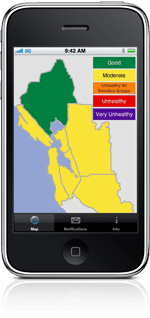
iSmog displays air quality information for the San Francisco Bay Area. With just a tap of the screen, users will see an easy-to-understand map of environmental quality in the Bay Area’s five air basins, built using data provided by the Bay Area Air Quality Management District (BAAQMD). With this information, commuters can make more informed choices about environmentally friendly transportation options, and members of sensitive groups will be better able to stay abreast of information that can be, literally, life-or-death.
Push notification alerts users with allergies or other environmental sensitivities when the air contains unhealthy levels of contaminants including ozone, carbon monoxide, nitrogen dioxide, sulfur dioxide, and two sizes of particulate matter, all precursors of ozone. Notifications can be customized by level of sensitivity and by geographic area.
New Unofficial Transit Map of All Rail in the Bay Area
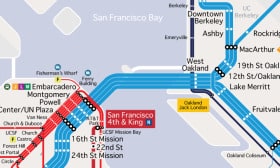 San Francisco Cityscape has just released its third version of a Bay Area rail map that includes all lines:
San Francisco Cityscape has just released its third version of a Bay Area rail map that includes all lines:
“The last version was more detailed; like the new BART map, it listed destinations that couldn’t be fit on the map. But we’d like to think that this version combines the simplicity of the BART map with a relatively accurate rendering of geography, and it includes some detail that the BART map doesn’t, like major Muni stops.”
Read more at the San Francisco Cityscape website and check out the map here.
